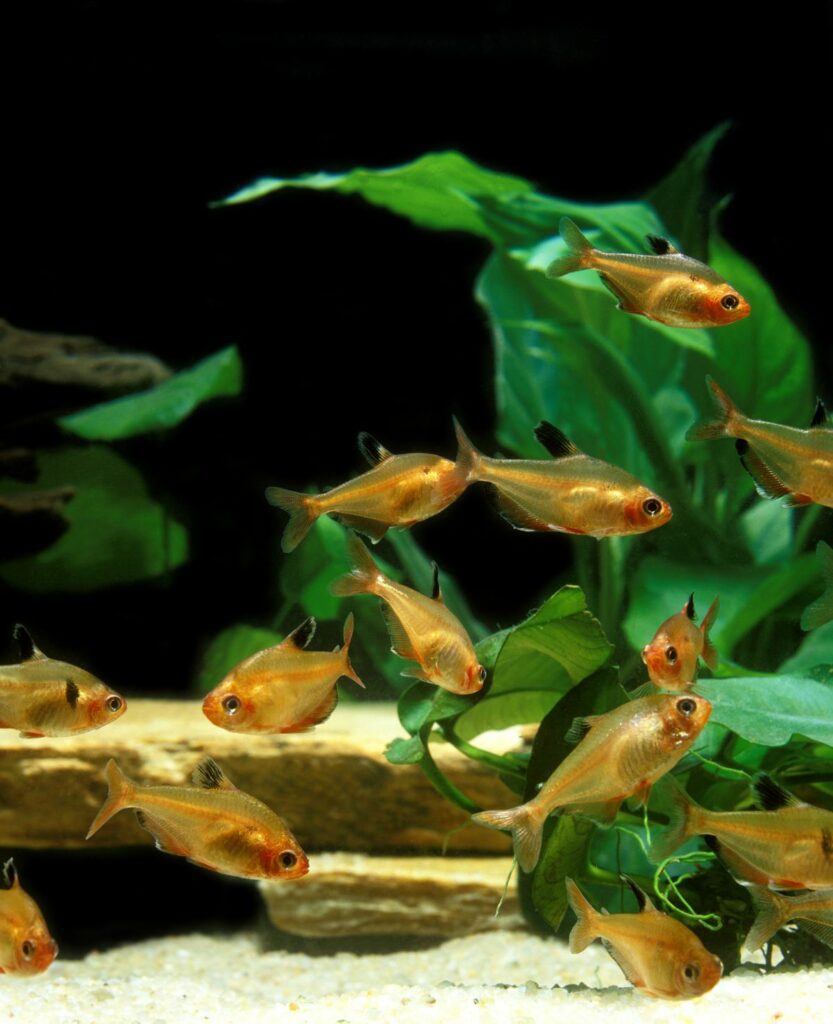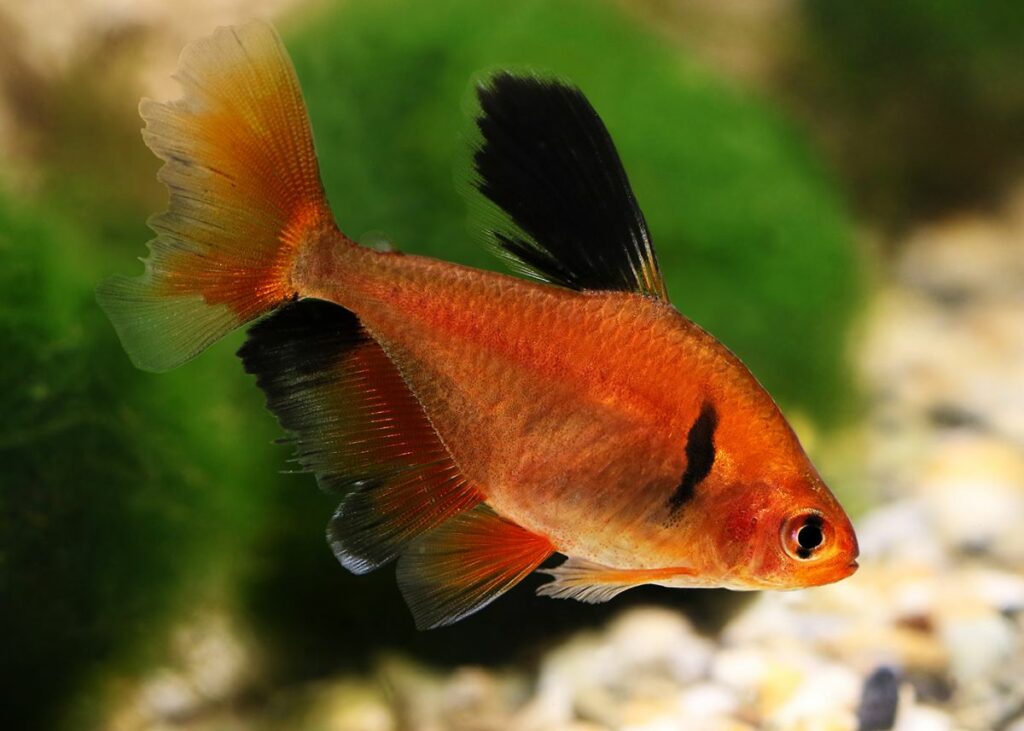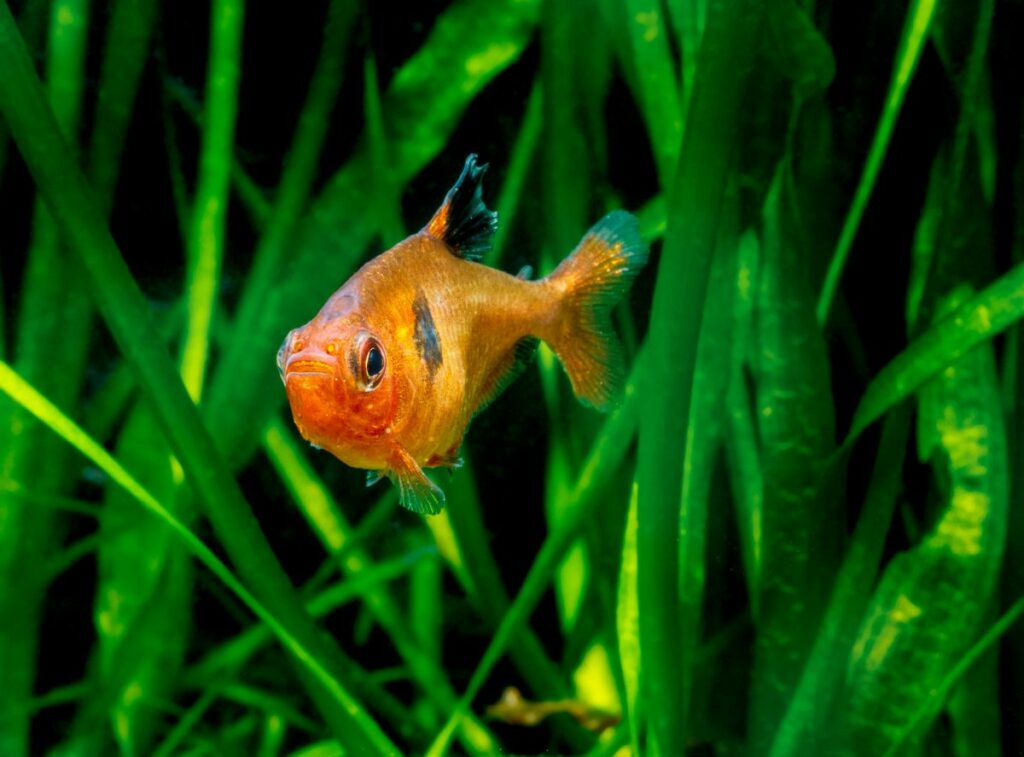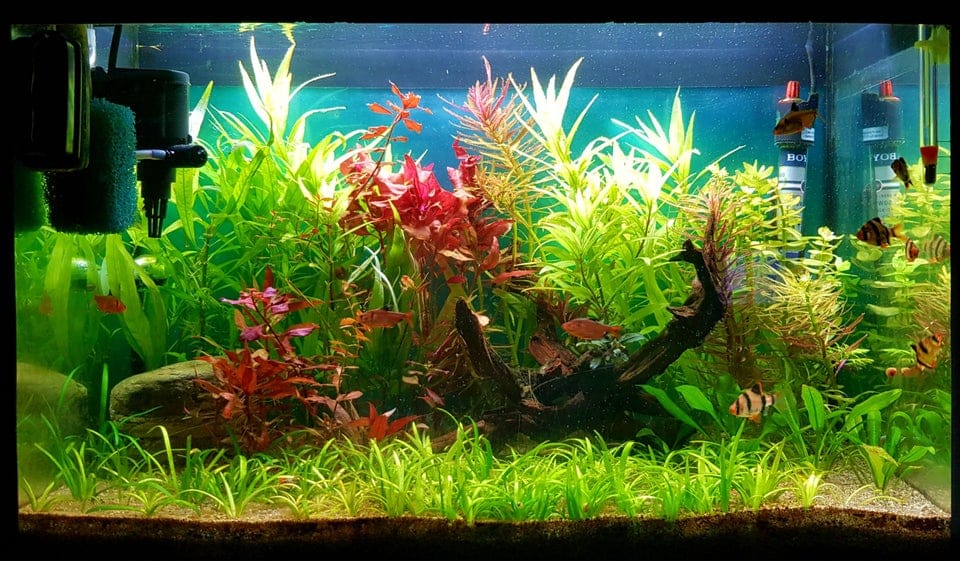The serpae tetra is a colorful addition to any aquarium. The contrast to their vibrant red flanks and black fins improves once you get them home. They are also ideal residents for planted aquariums. So how do you care for a school of serpae tetras?

What is the Serpae Tetra?
Serpae tetras are found throughout the upper Amazon River drainage basin (Brazil, Peru, and Bolivia). They prefer still or slow moving bodies of water, where they spend their time hiding from predators among aquatic plants.
When researching serpae tetras you might come across alternative scientific names. It’s possible that serpae tetras are really a species complex: a group of close relatives that look similar but are different animals.
Some populations have differences in color, size, and shoulder blotch shape. But all serpae tetras, regardless of the location or subspecies, share the same care requirements.
It’s easy to see how they get their alternative name of jewel tetra. Their brilliant crimson color and schooling habits make them instant focal points in any community tank.
They also go by the name red skirt tetra, comparing them to the much larger black skirt tetra (Gymnocorymbus ternetzi). But other than a superficial resemblance the two fish are quite different.
Black skirt tetras grow large, up to 3 inches long. Plus they are more aggressive and avid fin nippers. Serpae tetras remain peaceful, even towards long-finned tank mates.
- Common Names: Serpae Tetra, Red Minor Tetra, Jewel Tetra, Callistus Tetra, Longfin Serpae Tetra, Red Skirt Tetra
- Scientific Name: Hyphessobrycon eques
- Origin: Upper Amazon River basin
- Length: 2 inches
- Tank Size: 20 gallons
- Temperament: Peaceful; Schooling
- Ease of Care: Easy
Serpae Tetra Care
Serpae tetra care is similar to that of neon tetras and other small tetra fish. Keep water quality excellent, provide them with a varied diet, and they will live for several years.

Serpae Tetra Size
Serpae tetra size averages at around 2 inches. A quarter inch smaller is normal for males. And up to a quarter inch larger for females.
While they are small aquarium fish, red minor tetras are active and fast moving. They will spend the entire day darting from one end of the tank to the other. And exploring all of your decorations and plants.
Not to mention they are schooling fish. So despite their size, a 20 gallon tank is the absolute minimum for serpae tetras. A school should be no smaller than 6 individuals. With 8 to 10 serpae tetras being even better.
Tetra fish get stressed when kept in smaller numbers and even more so if kept alone. Even if there are other fish in the tank, tetras need their own company. In the wild, they live in schools of thousands of fish.
I recommend aquarium designs that favor floor space over height. A 20 gallon long offers more swimming room than a 20 gallon high, for example. Likewise for a 40 breeder vs a 40 long.
Serpae tetra lifespans are also impressive. Most aquarium fish their size live for just 1 to 3 years. But well cared for red minor tetras will live for 5 to 7 years.
Live Plants and Substrate Options
Red skirt tetras are one of the best aquarium fish for planted tanks. They are carnivorous so they won’t chew on plant leaves. The bright red color contrasts well against the deep greens of your plants. Serpae tetras also thrive in the same water conditions as most popular aquarium plants.
Plants, in turn, provide shade that reduces incoming light levels. The tetras feel less exposed, encouraging them to spend more time out in the open. Last, plants are necessary if you want to breed serpae tetras. As egg scattering fish, they need plants to lay eggs within.
Most plants you find in pet stores will do well in a serpae tetra tank. A mixture of broadleaf, grass-like, and moss-like plants is best.
Java fern, water wisteria, hornwort, Amazon sword plants, and vallisneria are all easy to find and care for. Add some Java moss to your rocks and driftwood and you have a simple planted tank that will look beautiful.
Floating plants are also good additions to any tetra tank. They cut down on incoming light even more. Helping to keep algae under control. They also don’t need bright lights or carbon dioxide enrichment since they live right near the surface.
Serpae tetras are not picky when it comes to substrate options. Gravel and sand are both acceptable since they only visit the bottom to pick at uneaten food. Try to find brands that don’t use limestone, sandstone, and other rocks that raise the pH.
Water Conditions for Red Skirt Tetras

Tetra fish are easy to keep but beginners sometimes struggle with them. They are a little more sensitive to nitrogenous waste products than livebearers, danios, and other beginner fish. Even low levels of ammonia are fatal to them.
They are so sensitive because many tetra fish are still wild collected. Tetras aren’t so easy to breed in captivity. So they prefer the same pristine river conditions they are collected from.
Ammonia and nitrite levels should remain as close to 0 parts per million as possible. Nitrate should stay no higher than 5-15 ppm. Plants need low levels of nitrate as fertilizer. But any higher will start to affect tetra health.
Red minor serpae tetras prefer an acidic to neutral pH (pH 5.5-7.0). With water that is soft (low in dissolved minerals). They will survive in hard, alkaline water but are more prone to diseases. Tetra fish also won’t spawn unless kept in acidic conditions.
Tap water in most countries is hard and alkaline. So how do we provide the right water conditions for tetra serpae? Adding plant matter that buffers the pH towards acidity will help.
Start with Indian almond leaves, small amounts of peat moss in the filter, and even pieces of driftwood. All of these will slow-release tannins and humic acids into the water.
Serpae tetra temperature should be moderate. You need to provide tropical conditions of 73-83℉; any warmer or colder will stress them.
What do Serpae Tetras Eat?
Serpae tetras are micro predators. Meaning they feed on small insect larvae, fish eggs, worms, tiny shrimp, and other small aquatic animals. Since they don’t eat algae or plants you shouldn’t feed them plant-based foods.
Serpae tetras eat flakes and micro pellets with gusto. But stick to brands that use shrimp meal, fish meal, krill, and other animal sources as the main ingredients.
Supplement your prepared foods with live and frozen foods. Brine shrimp, tubifex worms, bloodworms, and daphnia all add variety to their diet.
The extra protein and fat is even more important if you want to try breeding serpae tetras. Feed your serpae tetra fish 2 to 3 times per day. As much as they will eat in 3 to 5 minutes.
Serpae Tetra Tank Mates

Serpae tetra tank mates are easy to come by since the fish are so peaceful. Most community aquarium fish their size or a little larger will live with them. The main constraint is that any tank mates should prefer the same acidic to neutral conditions.
Other Amazonian fish make the best tank mates. There is such a variety of species to choose from that you are also able to set up a biotope aquarium. Here are a few choices to consider from all over the world:
- Other tetra varieties
- Cory catfish
- Cherry barbs
- Guppies
- Betta fish
- Dwarf otocinclus
- Kuhli Loaches
- Red Cherry Shrimp
Breeding Serpae Tetras
Breeding red tetra fish is not easy to do. They need excellent water quality and thick plant growth. Plus you need to feed them a variety of prepared, frozen, and live foods.
Serpae Tetra Male or Female
Sexing tetra fish is never easy. The visual differences are very subtle, even in full grown serpae tetras. Your best bet is to buy as many as possible, so you’re guaranteed to have females.
Otherwise, you can examine their body shape and behavior. Male serpae tetras are not as thick as female tetras. Males also spend more time jousting and nipping at each other, while females will patrol the entire tank in pieces.
When a female ripe with eggs comes close he will flare his fins and try to get her attention. Females that become pregnant with eggs will swell up enough for you to notice the difference.
Spawning Serpae Tetra Fish
Once the fish are conditioned to spawn they will pair off on their own. The female will choose a male of her liking. And they will dart into plant thickets at dawn or at dusk, when it’s still possible to see. But light levels are low enough to hide from predators.
The red tetra fish then embrace among the plants, scattering their eggs to fall where they will. They provide no further parental care after that. They will even forget they spawned and try eating their eggs after a few hours.
You should remove any plant stems with eggs attached to a fry rearing tank. Next, allow the eggs to develop, where they will hatch in 2 to 3 days. The fry are tiny and require cultured infusoria as their first meal.
After their first week, the fry are large enough to take baby brine shrimp nauplii instead. At this stage, you should start weaning them onto crushed flakes as well.
Conclusion
Serpae tetras are bold, colorful additions to any community of small fish. They look even more beautiful when light levels are kept low and plant growth is thick. And with luck, you might even have them spawn for you.
FAQs
6 fish is the bare minimum for a school of serpae tetras. 8 to 10 fish is more comfortable. And if you have space, feel free to buy even more. These fish love the company of their own kind.
Serpae tetras don’t nip fins when kept in groups of 6 or more fish. They will focus on each other instead. Groups of serpae tetras that are too small will sometimes nip tank mate fins, however.

